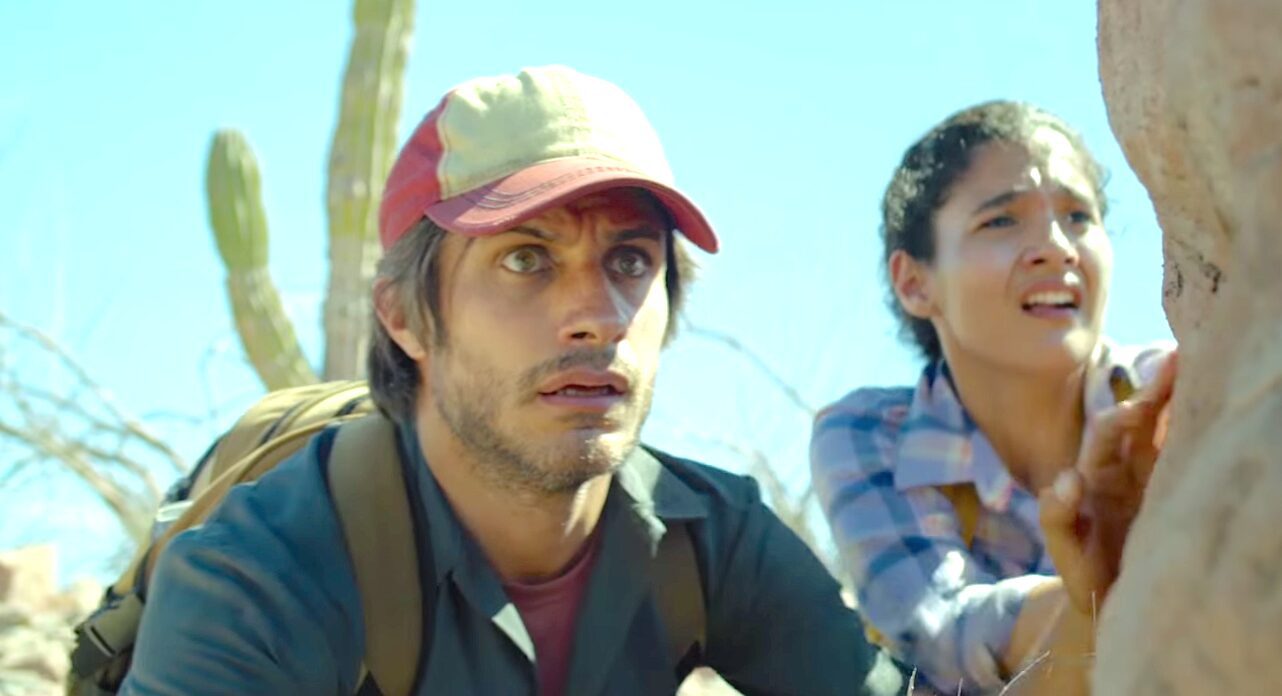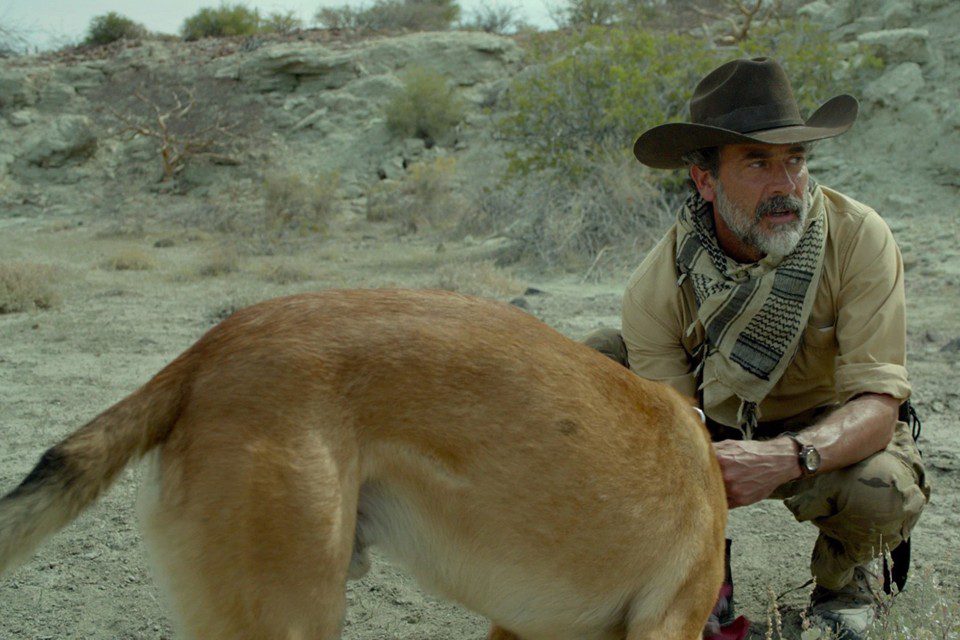“I used to love this place. Not anymore. I hate it.”
A lone truck, infinitesimal, trundles across the scrublands of the desert. Mountains loom in the background like ancient sculptures. The camera is immobile as the night gives way to day and the title of the film arrives in letters taking up almost the entire screen: DESIERTO. It’s a panorama straight out of a John Ford film, and the message is clear: this land does not belong to men.
Like its opening shot, Desierto is a pleasingly straightforward film. In the vein of Ford westerns, it doesn’t concern itself with murky morality or existential underpinnings. There is good here, and evil, and never shall one be confused for the other. It’s simple in the same way an urban legend is – and it’s incredibly timely. In many ways this is the feverish kind of horror film that is perfectly of its moment, one that could only have been made in 2016.
There are two trucks in Desierto, and through the course of the film they are both taken out of commission. As the border desert is Stygian, so are the trucks like the boat of the ferryman Charon; when they are no longer operable it is as though the film’s characters are stranded in a kind of Limbo. The first truck is full of immigrants from Mexico, being taken across the border by a coyote named Lobo. It breaks down and Moises (Gael Garcia Bernal) is unable to fix it, so he and his fellow migrants have to make it to the border on foot.
The other truck belongs to Sam (Jeffrey Dean Morgan), a lonely vigilante whose anger and unchecked homicidal urges do little to mask a deep well of sadness and a sense of displacement. He arrives in the desert with his dog Tracker. Everything about Sam is a throwback, from his truck’s tape deck to his antiquated views on race and his role in a nonexistent war involving it. “Shall we go hunting?” he asks Tracker, and in a nice subversion of expectations, he actually does, shooting a rabbit and preparing to make his way home – until he sees the group headed for the border.
Desierto moves with impressive alacrity; once Sam notices the migrants, he makes up his mind instantaneously to take action, which comes in the form of him crouching down and picking them off one by one. It’s quite frankly stunning the body count that he racks up in such a short time; in only a few minutes, he’s killed eight people, more than most killers do in an entire movie. It’s an impressively brutal introduction, and Morgan takes the role of Sam and runs with it. Back in his truck, his composure is stripped away as he laughs, cries, drinks whiskey straight from a bottle, all while hollering “My country! You won’t fuck with me now, will ya?” It’s here that you realize Sam’s motivation is more than just pure racism (although that is certainly a huge factor at play): he’s a man who feels, in his words, fucked with by his country, and the men and women crossing the desert are that fear made manifest.
Unfortunately, not many of the migrants are fleshed-out enough to make their deaths good for much beyond shock value, which is lessened with each kill. As the co-lead of the film, Bernal’s Moises gets the most backstory, but I still had to check IMDb to find out his name. Bernal does fine work, though, downplaying his movie-star good looks and appealing guilelessness to play a man stuck in an impossible, hellish situation. Director Jonas Cuaron (who co-wrote with this father Alfonso; before this the two collaborated on Gravity) might have backed himself into a corner with the sheer volume of characters he works with here. Desierto might work better if it were half an hour longer; as it is it plays its hand too quickly, and we know that the only migrants who might survive this ordeal are Moises and Adela (Alondra Hidalgo).
Cuaron excels at staging, though. The camerawork is deliberately staid and not flashy; Cuaron lets his setting do the work it’s intended to. So far from civilization, the desert doesn’t just look foreign, it looks alien – Martian or Plutonian. Not just unforgiving but hostile. One wonders what Cuaron could have done with a longer runtime, which would have allowed him to involve the environment more – the film could benefit from scorpions, dehydration, sunburn, any of that.
There are two nice moments like that, though. Adela tumbles down a hill and finds herself in a nest of rattlesnakes, the sheer volume of which is terrifying. Later, she uses the selfsame snakes to stage a trap for Sam and Tracker, which regrettably is about as much as she’s given to do in the film. One of the film’s strongest sequences comes when Moises has to crawl through a bramble of cacti, with Tracker on his heels the whole time. The dog – whose name I couldn’t find online, but who is a very good boy – is a phenomenal animal actor, and Sam treats him less like a servant than a sidekick (incidentally, the dog sidekick is a great idea because it gives Sam a reason to speak out loud, rather than just talking to himself). It’s a tense and visceral sequence, and Cuaron puts an unpleasant exclamation point on it by having Moises shoot a flare directly into Tracker’s mouth. The dog’s death helps humanize Sam, and Morgan’s best acting in the film comes when he discovers Tracker’s body, smoldering form the inside, and has to put him out of his misery. Sam’s howls are animalistic and primal, and Desierto should be commended for affording such dimensionality to a racist murderer.
Philosophically speaking, Desierto doesn’t play nice with its American audiences. It’s a direct attack on our Draconian immigration policies, and the backwards-thinking bigots like Sam who have declared open season on the border. Even with the film’s faults in mind – an overstuffed cast, underdeveloped characters, plot points telegaphed a little too far in advance – I can’t help but admire its boldness.
The title is in Spanish because the experience of Moises and the other migrants is uniquely not an American one – the villain is even named Sam, for God’s sake, as in Uncle, and while that might be incredibly unsubtle it’s also very effective. Thousands of men and women make the passage to America from Mexico, risking their lives. They’ve been told that America is the land of opportunity, only to find monsters waiting for them – a literal one, in this case. Have you ever heard the story that ends with “The call is coming from inside the house”? Remember what I said about Desierto seeming like an urban legend?
10/1: Dawn of the Dead
10/2: Drag Me to Hell
10/3: Pet Sematary
10/4: The Descent
10/5: Repo! The Genetic Opera
10/6: Desierto
10/7: The Blair Witch Project
10/8: Blair Witch
10/9: The Texas Chainsaw Massacre
10/10: A Nightmare on Elm Street (2010)
10/11: Prince of Darkness
10/12: 30 Days of Night
10/13: Friday the 13th (2009)
10/14: Slither
10/15: Tremors
10/16: Pandorum
10/17: It Follows
10/18: A Girl Walks Home Alone at Night
10/19: Poltergeist
10/20: Paranormal Activity
10/21: Creepshow
10/22: VHS
10/23: Nosferatu the Vampyre
10/24: An American Werewolf in London
10/25: The Witch
10/26: The Rocky Horror Picture Show
10/27: Cronos
10/28: The Hills Have Eyes
10/29: The Hills Have Eyes (2006)
10/30: Tucker & Dale vs. Evil
10/31: Halloween (2007)



